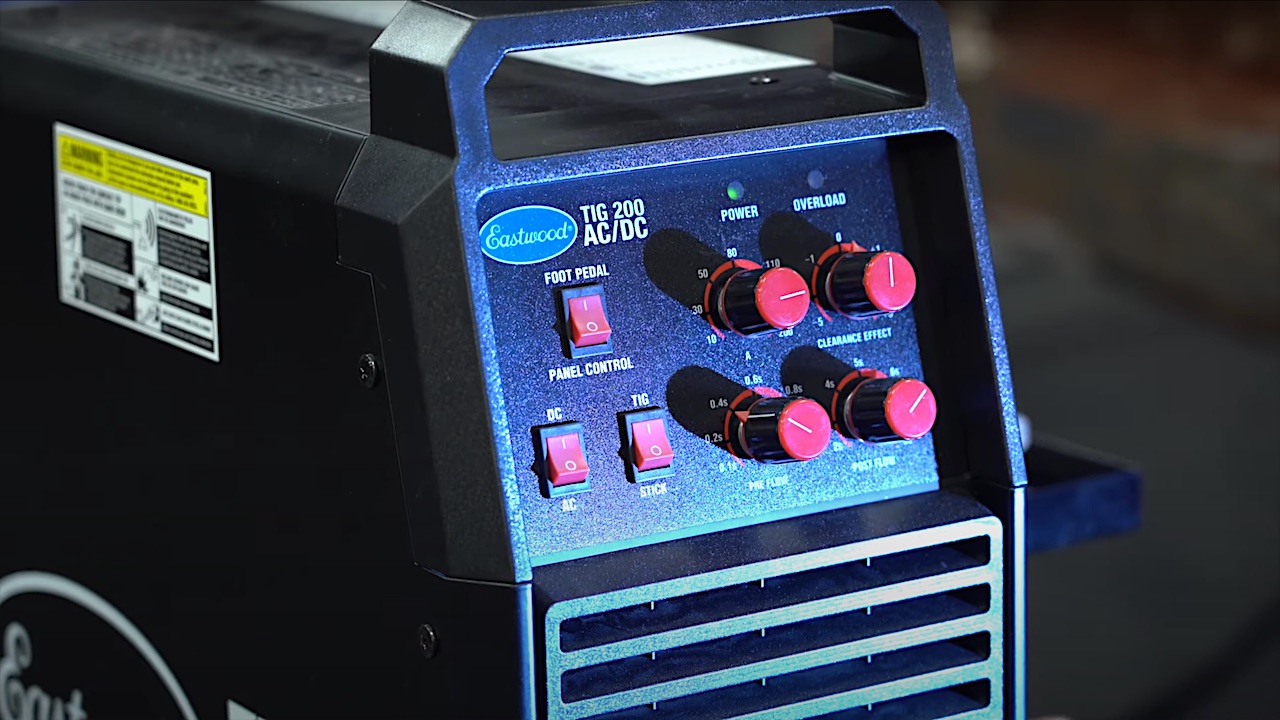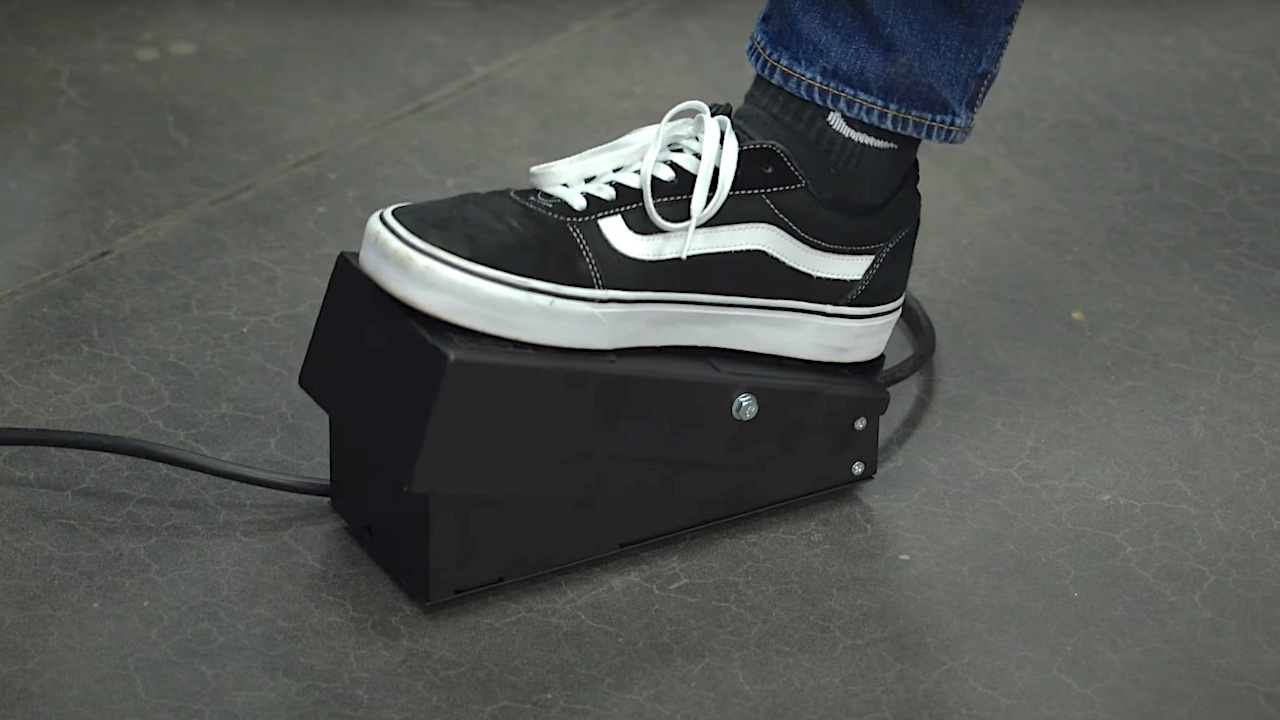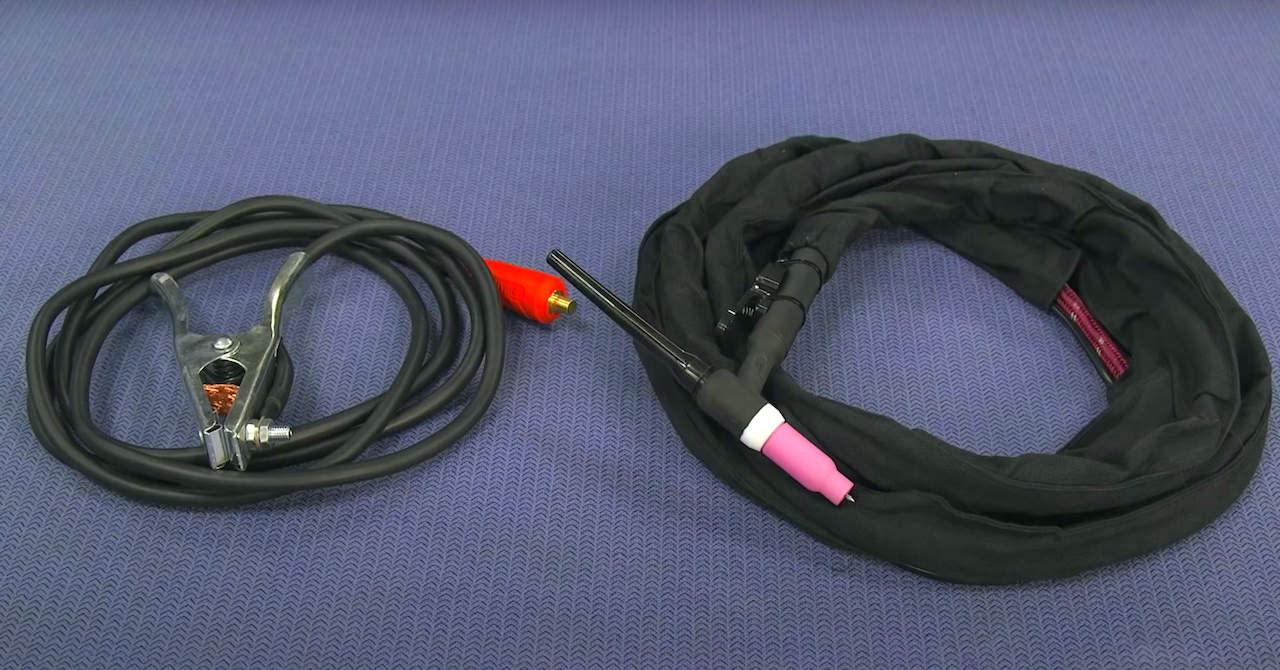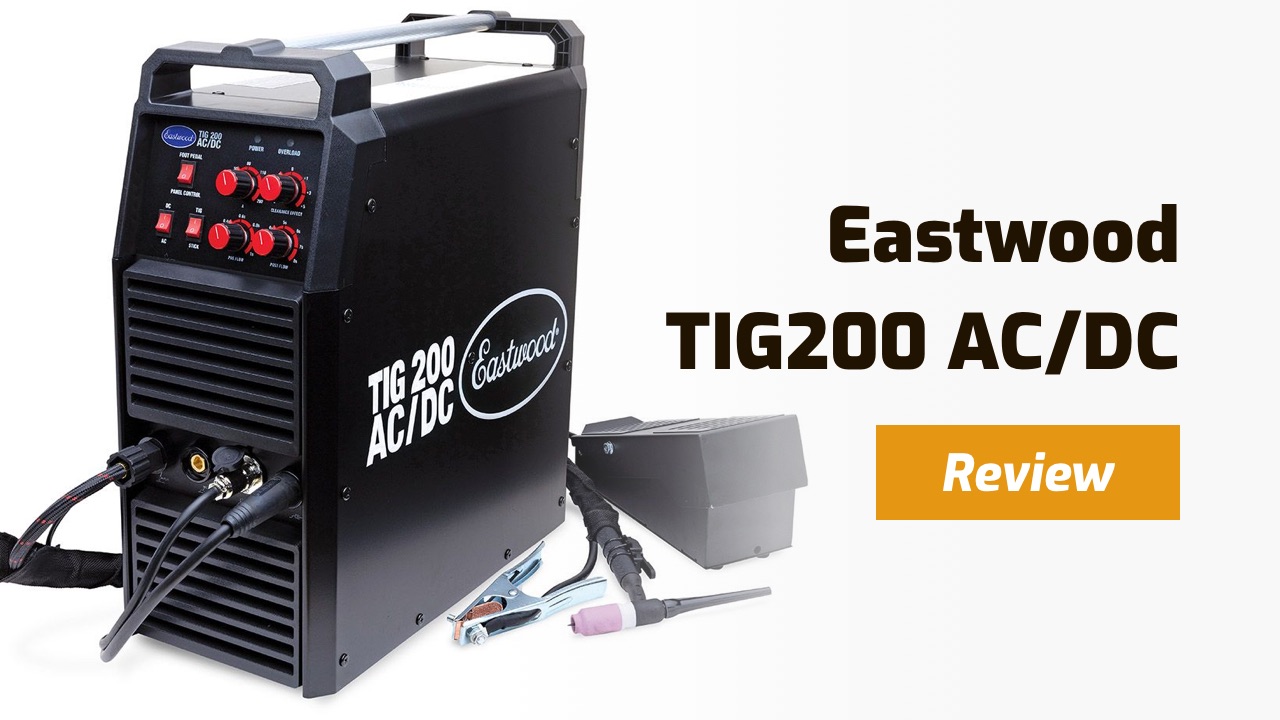The Eastwood TIG 200 AC/DC welder offers a great set of features for many small to medium-sized shops, at an affordable price.
But things just got better for the Eastwood TIG 200 AC/DC with a July 2021 upgrade!
This welder makes great-looking TIG welds possible for those who may have assumed this capability was beyond their shop’s budget.
So, while this was an interesting TIG welder before the upgrade, it is even more compelling after. But what was changed in the new upgrade? Well, I updated this product review to bring you all the details.
Read the Eastwood Elite TIG 200 LCD Digital review here.
Quick Overview of the Eastwood TIG 200 AC/DC

What’s Included
- TIG 200 AC/DC Welder with NEMA6-50P Plug
- Shielding Gas Flow Meter/Regulator
- Shielding Gas Hose (4.6’)
- Ground Cable with Clamp (9.5’)
- Flex Head TIG Torch (17 Series) (12′ lead)
- Rocker Style Foot Pedal for Amperage Control (16’ Cable)
- 110-120 VAC to 220-240 VAC Adapter Plug
- Instruction Manual
- Hand-Held Shield
- Hammer/Brush
- #8 Gas Lens
- Long Back Cap
- Short Back Cap (Installed)
- 3/32” Collet Body (Installed)
- 3/32” Collet (Installed)
- 3/32” x 6” Red Thoriated Tungsten Rod
- 3/32” x 6” Green Pure Tungsten Rod
Technical Specifications
| Welder Type | TIG & Stick |
| Stated Input Voltage | 110-120 / 220-240 V |
| TIG AC Duty Cycle | 60% @ 190 A (240V) 60% @ 100 A (120V) X |
| Stick Duty Cycle | 60% @ 185 A (240V) 60% @ 60 A (120V) |
| Output Amperage | 10 – 200A |
| Current Output | AC/DC |
| Manufactured In |
China |
| Weldable Materials | Steel, Stainless, Aluminum |
| Weld Thicknesses in Settings Chart |
Thin gauge – 1/4 in. |
| Torch Control |
Trigger: On/Off |
| Foot Pedal | ✅ |
| Trigger Switch on Torch | ✅ |
| Stick Electrode Holder | ⛔ |
| Square Wave Technology | ✅ |
| Variable Pulse | ⛔ |
| Pre and Post Flow Control | ✅ |
| Clearance/Cleaning Setting | ✅ |
| High-Frequency Start | ✅ |
| Welder Dimensions (H x W x L) | 17.8 in. x 8.4 in. x 20.2 in. |
| Weight | 38 lbs. |
| Warranty | 3 years |
| Price | Check Latest Price Eastwood |
Pros
- Runs on 110-120V or 220-240V input power
- 10-2190A of current output
- Can be powered by a generator
- Light and portable
- Square wave, inverter-based design
- Good duty cycle
- High frequency starts
- Finger switch on the torch
- Gas regulator and hose included
- Infinite pre and post flow gas control
- Can stick weld with optional electrode
- Affordable
- Good warranty
Cons
- Stick electrode holder not included
- No true pulse control
- No water-cooled torch option
- Argon gas only
Where to buy the TIG 200
The best and cheapest place to buy this machine is the official Eastwood online store.
What You Should Know Before Buying the Eastwood TIG 200
Stick Welding
We all appreciate versatility, and this TIG welder can double as a stick welder. However, you should know that the electrode holder for SMAW welding is not included.
You must purchase an electrode holder separately. If you plan on using the stick welding feature, factor the cost for an electrode holder into your costs.
Foot Pedal

Eastwood has upgraded to a rocker-style foot pedal, which is preferred by most welders. But it still has the dial on the pedal to set the maximum amps. Eastwood did this so welders could reset their max amps on the foot pedal without going back to the machine.
However, some welders dislike the foot pedal dial. Since it is located on the foot pedal, that means bending over or getting down on the floor to change the setting. It depends on your personal preferences.
Pulse Mode
Some welding processes use an output electrical current that fluctuates in a wave pattern. For example, welding aluminum requires an AC output current that oscillates between positive and negative. This form of current is said to be “pulsed.”
Welders using pulsed electrical output may allow you to control the width and height of the wave. This allows for better control of your arc. It helps to prevent overheating or burning through thin materials. Plus, it can also help to prevent warping.
On thicker stock, good control of this sinusoidal wave also you get better penetration with a thinner bead and less heat. You also use less current, which results in a better duty cycle and more welding time. The pulsing action also helps to clean the weld.
So, there are advantages to having pulse control on a TIG welder to have better control of your penetration and cleaning action when welding aluminum. (For the record, do not confuse this with “pulsing” of the foot pedal, which does not control the height/width of the current wave).
The TIG 200 AC/DC does put out a squared wave (which improves performance). Unfortunately, the TIG 200 AC/DC does not include true pulse control. It does, however, have a “clearance” knob that gives you a way to tweak the heat and cleaning action of your arc.
The amount of penetration versus cleaning can be adjusted with the included clearance knob. In essence, it is a simplified version of the pulse feature. Tweak the penetration up, and it lessens the cleaning action. Or lower the penetration and you increase the cleaning performance.
If you need a true pulse feature (e.g., where you can adjust the width and height of the pulse) to work on delicate or very thin work, you may want to look at Eastwood’s TIG 200 Digital AC/DC welder which does include true pulse control.
2T and 4T
On some machines, the torch trigger can be used with a 2T or 4T method. The designation refers to whether you “touch” the trigger two or four times.
With the 2T method, you press the trigger to start your arc. Then you hold the trigger for the entire weld, and finally, let go of the trigger when you want to stop the arc.
For long welds, the 4T feature can be useful. You touch the trigger to start the arc, then release it to run your bead. When done, press and release the trigger again to stop. You don’t have to hold the trigger down as you weld and your finger does not get tired using the 4T option.
The Eastwood TIG 200 AC/DC uses a 2T method. Along with the HF starts (see below for more on the HF feature), it makes starting and running a bead simple. But it does not include a 4T option. For those who do long runs using the torch trigger, this could be an issue.
Top Features of the Eastwood TIG 200 AC/DC
Price
TIG welders can get pricey. But the Eastwood offers the TIG 200 AC/DC at a great price compared to the prices for similar competing machines. The low cost makes TIG welding possible for shops on a tight budget.
If you do not need the AC output current, you can save even more money by considering Eastwood’s TIG 200 DC welder, which only provides a DC output current.
Upgraded Rocker-Style Foot Pedal
On the old version of the TIG 200 DC, the foot pedal left many users unimpressed. Eastwood must have been aware of the issue as they used to offer an upgrade to a rocker-style foot pedal. But it was expensive.
With this new upgraded model, problem solved. They include the rocker-style foot pedal as standard with the new, upgraded welder. Comfort and control are better with this pedal and including it was a definite improvement.
New Gas Lens
The upgraded model includes a gas lens. This focuses your shielding gas for better coverage of your welds. That means fewer porosity defects and better welds.
This also allows you to stick the tungsten electrode out a bit further, which allows you to get into tight spaces, while still getting get good gas coverage.
Portable
The case is about the size of a medium hard-side suitcase. It is not tiny, but not too big either. Add to that it only weighs 38 pounds, and you easily can move the unit around if needed. Eastwood even included a nice handle on the top to make picking it up simple.
Versatile Input Power Supply
One of the issues that can arise when taking your welder to the work – finding a power supply. As already stated, you can move this unit around when necessary. That’s nice. But you can also run the TIG 200 AC/DC on 120 or 240 volts (the adapter plug is included). That’s flexibility.
So, bring this welder to where it is needed since finding a standard wall outlet is usually not that hard. Or, maybe getting 240V out to your shop is not impossible. The ability to run on dual voltages lets you use this welder with the input power supply you have.
When no outlet is available, you can also run the TIG 200 AC/DC on a generator (7,400W min, but 12,000W recommended by Eastwood). You have plenty of options for input power, which is not true of every welder.
Dual Output Currents
A fair amount of welding is done using a DC output current. But when welding aluminum, it is well known that you should use an AC output current.
With the Eastwood TIG 200 AC/DC, that is no problem. You have the option to use either output current, AC or DC, meaning you can tackle more tasks using this one welder, which includes aluminum.
Duty Cycle
When compared to more expensive units, you will likely appreciate this unit’s smaller price tag. But many assume low cost equals a low duty cycle. Something like 20% if you are lucky.
However, Eastwood shunned that pessimism and built the TIG 200 AC/DC to carry a 60% duty cycle at 190 A (220V). That’s not anything to sneeze at, and smaller shops should find this meets or exceeds their needs.
10 – 200 Amps of Power
Budget welders can leave users less than impressed. That often happens when you realize the power range is not adequate, namely the welder tops out at low amps.
Of course, having ample power is important. With the Eastwood TIG 200 AC/DC, you can go up to an impressive 200A. This means you have enough heat to tackle up to ¼ inch thick stock in a single pass.
But the low end can be important, too, when dealing with thin stock or delicate pieces. Eastwood built the TIG 200 AC/DC to go down as low as 10A, for those times when you need it.
This output amperage range fulfills the needs of most small or medium-sized shops. Just keep in mind, to get the most power out of the unit, you will need to use the 240V power input option.
Torch and Ground Clamp

The ground clamp will satisfy all but the most discriminating. It does come with a braided wire strap to connect the jaws and Eastwood provided adequate quality for it to hold up in most shops.
The upgraded flex head 17 series torch is a nice surprise. Now, you can set the angle of the torch tip just right when you find yourself in those awkward, tight positions. (For those who are asking, no, the trigger switch does not vary the current output. It is an on/off trigger only.)
Not a minor thing, you can find parts for this torch just about anywhere, including big box stores. That means even on weekends or after hours you can find parts. That’s appreciated by weekend warriors.
High-Frequency (“HF”) Arc Start-Up
Some of the online threads discussing the TIG 200 AC/DC often include a popular question on whether or not this a lift start unit. That’s because, at this price point, a high-frequency (“HF”) start would be unusual. HF star is typically found on only professional/dedicated TIG welders.
But this welder includes a high-frequency start feature. That means, set your tip over the spot where you want to weld, pull the trigger or press the foot pedal, and you are off and running. No scratch or lift necessary. The bottom line, you have better arc control during starts.
Pre and Post Gas Flow Control
One of the things necessary for a TIG weld to work, argon gas. It shields the weld from reactive gases in the air as the bead cools. It is crucial to a strong, quality weld. That also involves keeping the start and end of the weld blanketed in argon gas just before and after the arc.
To make that easy, Eastwood gives users of the TIG 200 AC./DC pre and post-flow gas control. You can set the start and ending flow times to properly shield the start and end of the weld you are doing, without wasting argon gas.
Warranty
A good warranty shows a manufacturer believes in the quality of their product. Eastwood understands that and tackles the issue head-on.
The Eastwood TIG 200 AC/DC comes with a 3-year no-hassle warranty. Based on customer comments, they take this commitment seriously. If you look, you will be pleasantly surprised with the positive comments on how they solved problems and satisfied customers.
For those looking for a TIG welder, but are nervous about making a large purchase, service and warranties are important items. If that is you, the warranty and service offered by Eastwood are something you should check out on your own to ease those nerves.
What Other Users Are Saying
One of the more repeated things users say, this unit is easy to use. The dials and switches are clearly labeled and minimal for a TIG welder. The unit starts smooth and allows even new welders to lay down nice beads.
Those new to TIG welding often say they are surprised to see how nice a bead they create using the TIG 200 AC/DC. That includes aluminum, too. So, this machine is a good first TIG welder for newcomers.
Also, the majority of comments praised the price to performance ratio of this machine. One user summed it up best by saying this TIG welder is “the best bang for the buck.”
Another interesting often repeated comment from users, the duty cycle is not overstated. Many welders note how surprised they are to have never tripped the duty cycle of the machine.
Alternatives to Consider
Eastwood TIG 200 vs TIG 200 Digital
If you know you’ll have access to a 240v power supply, then it’s worth considering the digital version, the TIG 200 Digital AC/DC.
The key differences are highlighted below.
| Eastwood TIG 200 | Eastwood TIG 200 Digital | |
|---|---|---|
| Power Input | 120V / 240V | 240V only |
| Dimensions (H x W x L) | 17.8 in. x 8.4 in. x 20.2 in. | 13 in. x 8.5 in. x 18.5 in. |
| Weight | 38 lbs. | 60 lbs. |
| Welds Aluminum | ✅ | ✅ |
| Pulse Mode | ⛔ | ✅ |
| Digital Display | ⛔ | ✅ |
| “Large” Rocker Style Foot Pedal | ✅ | ✅ |
| 4T | ⛔ | ✅ |
| Latest Price | Check Here | Check Here |
Lincoln Square Wave TIG 200
Another premium choice TIG welder that gets compared to the Eastwood TIG 200.
We already have a detailed comparison of these two, which you can find here.
Conclusion
You do not have to go without a TIG welder if your shop needs one. The recently upgraded Eastwood TIG 200 AC/DC can be bought for less than most competing units without sacrificing what a TIG welder does best.
When you consider the price, all the features packed into a welder that produces good-looking welds make the TIG 200 AC/DC one of the best values for a TIG welder. But you also get a no-hassle 3-year warranty for peace of mind.
This easy-to-use machine is great for beginners while still offering the capabilities that advanced welders want and need. With the recent upgrade, even those who aggressively work the foot pedal will be happy with the welder right out of the box.
The 60% duty cycle may be a little too low for larger, industrial shops. But, the TIG 200 AC/DC will be at home in small to moderate-sized shops, as well as some larger shops that do not need a higher amp output or duty cycle.
Eastwood caters to the auto restoration/customization market. But many artists, mechanics, DIYers, and ranchers/farmers, will find this capable TIG welder hits a sweet spot for them as well.
Other Eastwood Reviews
Eastwood 135 MIG Welder Review

Thanks Jeff, I have been looking into getting a Tig welder for my home shop. I am cautious about spending the money on one of the name brand welders but also don’t want to buy a low cost machine that I might later regret. Thanks for this review , I think this Eastwood unit might be a smart buy.